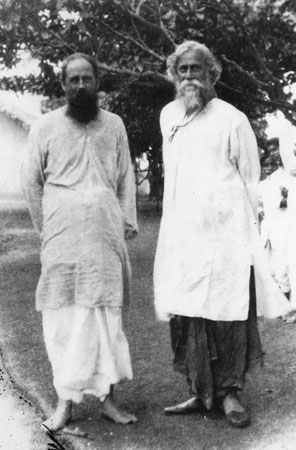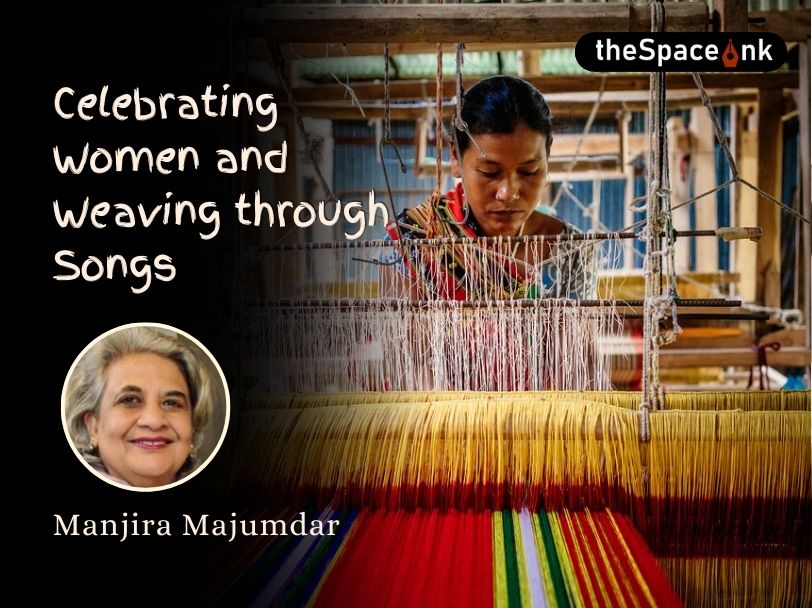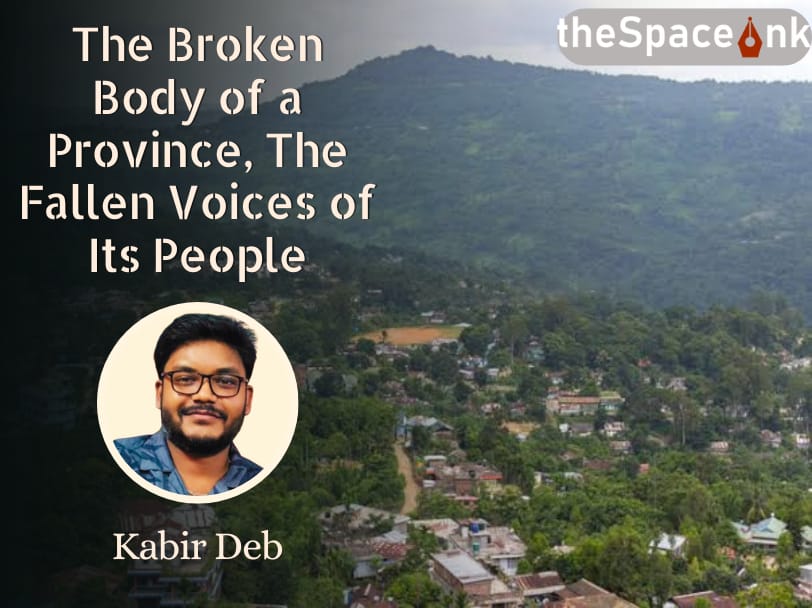The Visva-Bharati University was founded by Nobel Laureate Rabindranath Tagore on December 23, 1921. To commemorate the commencement of its centenary year, thespace.ink will publish a series of special features in the weeks to come. This is the first essay of the series.
In a letter dated 11 October 1916, Rabindranath Tagore (1961-1961) wrote to his son Rathindranath: ‘I also remember that the Santiniketan school must be developed into a thread linking India with the world. It is here that a centre for the cultivation of universal humanism must come up… the victory flag of the universal man must be sown here. The efforts of my last years shall be to uncoil the world from the bondage of national sentiment.’ Earlier, in 1913, Rabindranath had confided to Andrews his desire to ‘cultivate the feeling of international fellowship among the boys of our school and that of some schools in the West. These letters reveal to us Rabindranath’s plans for establishing an institution that would become a center of international culture. On 22 December 1918, Rabindranath declared to the inmates of his Santiniketan School his intention of setting up an institution to be named Visva-Bharati; visva, in Sanskrit, means the world in its universal aspect, and bharati means wisdom and culture. Its motto in Sanskrit is yatra visvam bhavate eka nidam which in English means ‘where the world meets in a nest.’
Visva-Bharati was initially meant to be a centre for the confluence of Eastern cultures, as Rabindranath noted in The Visva-Bharati Ideal in 1924. As such, the initial focus was on the study of Sanskrit, Pali, Buddhist, Prakrit, Tibetan and Chinese literature. This was because Indian, and for that matter, eastern cultures were studied more critically and comprehensively only in Europe. The Indian educational system being under British control, Indians had lost the sense of creativity required for the pursuit of their own culture, Rabindranath argued. But his visit to the West in 1920-21 changed his views and he now wanted his institution to be a centre for the meeting of Eastern and Western cultures, thereby bringing the entire humanity within its ambit. This would enable India to enlarge her vision of the world, transcend her parochial boundaries, extend the horizon of her intellect and imagination and also erase the divisions and hierarchies existing between the East and the West.

It needs to be remembered that Rabindranath was pursuing the ideal of uniting humanity into a single whole in a post-World War I world. Except for a few intellectuals, the political establishment in the West did not think about coming closer to the East; a larger part of the Orient was still colonized by it! In 1923, Rabindranath noted that ‘[t]he time has come to proclaim that man is for all nations, for all ages. He has no nationality, no discrimination of race. Since this identity of man has not been established, he wants to grow richer by robbing others.’ [translated] Culture, he thought, alone could serve as a bridge across international divides.
The key idea at the root of Visva-Bharati, then, is that of culture. Rabindranath often used the word as a synonym for education. Education for Rabindranath did not mean sheer pedagogical training, what he derisively called ‘grammar and laboratory’; it carried the wider ramifications of intellectual and spiritual refinement. He noted in Creative Unity that ‘[m]an’s intellect has a natural pride in its own aristocracy, which is the pride of its culture. Culture only acknowledges the excellence whose criticism is in its inner perfection, not in any external success.’ But this Arnoldian principle is only one of the threads in the texture of the Visva-Bharati ideal.
Visva-Bharati was to emerge as a unique centre for the cultivation of the human intellect and the human personality through the dispassionate pursuit of knowledge. But the knowledge was not meant for utilitarian and worldly achievement. ‘A lighted lamp is for the end of us and not a lump of gold’, Rabindranath had written to Leonard Elmhirst, and had urged ‘[l]et us bring all our power of imagination and create a world.’ But Rabindranath was not indifferent to man’s basic needs; he, therefore, did not stop at culture. Incidentally, the English word ‘culture’ originally meant several things of which one is cultivation or tending. Rabindranath’s idea of complete education involved integrating culture with agriculture (and allied activities) on the ‘co-operative principle’, even bringing adjoining villages within its ambit. In September 1921, the Rural Reconstruction Institute at Surul began to function in full bloom as Leonard K Elmhirst took up the charge of the institution. Tagore’s integrated vision of Visva-Bharati thus began to acquire full shape.
Visva-Bharati as Rabindranath conceived it, was not modelled on western universities, but stood as an alternative to them. In 1924, Rabindranath explained his idea to William Rothenstein, the English painter, very powerfully that ‘that word [university] … tortures my idea into its own rigid shape. … I should not allow my idea to be pinned to a word like a dead butterfly for a foreign museum … I have saved Santiniketan from being trampled into smoothness by the steam roller of your Education department. … I am proud of the fact that it is not a machine-made article perfectly modelled in your workshop.’ The free pursuit of knowledge as an ideal is, however, not to be construed as knowledge for its own sake as John Henry Newman had argued in his The Idea of a University. ‘Universities’, Rabindranath cautioned, ‘should never be made into mechanical organizations for collecting and distributing knowledge. Through them the people should offer their intellectual hospitality, their wealth of mind to others.’ Ideally, the aim of education, as he envisioned, ‘should lie in imparting life-breath to the complete man, who is intellectual as well as economic, bound by social bonds, but aspiring towards spiritual freedom and final perfection.’ We have already seen how Visva-Bharati integrates both intellectual and economic requirements.
I should not allow my idea to be pinned to a word like a dead butterfly for a foreign museum … I have saved Santiniketan from being trampled into smoothness by the steam roller of your Education department. … I am proud of the fact that it is not a machine-made article perfectly modelled in your workshop.
Rabindranath Tagore Tweet
In the final analysis, it needs to be noted that scholars have foregrounded what may be called the spiritual, if not the moral, underpinnings of the Visva-Bharati ideal. This is to forget the fact that Visva-Bharati is the creation of a poet and artist’s imagination. Rabindranath himself called it ‘a poet’s school’, and he virtually thought of Visva-Bharati as a work of art. ‘I am an artist and not a man of science, and therefore, my institution has necessarily assumed the aspect of a work of art and not that of a pedagogical laboratory’, he had declared publicly in 1931, adding that, ‘[f]or intellectual knowledge also has its aspect of creative art, in which the man who explores truth expresses something which is human in him.’ The idea, by Rabindranath’s own confession, is a ‘growing’ idea, ‘elusive’ in nature, and therefore not subject to rational ‘analysis’. This statement should not be read as an artist’s or a poet’s evasion; nor are they comparable with Friedrich Schiller’s idea of the aesthetic education of man. What really needs to be thought about after a century is that the ideals of Visva-Bharati are best understood through a broad, aesthetic frame. And only those with an alert aesthetic sensibility would be able to understand and cherish those ideals.
All images used in this article are in the public domain.
Sirshendu Majumdar teaches English at Bolpur College. His areas of interest are Irish Studies, Translations, Print Culture and Literary Modernism. He has written a book on Yeats and Tagore and has published in academic journals and the popular press both in English and Bengali. He lives in Bolpur with his wife and daughter.








One Response
Rabindranath’s Visva-Bharati is truly a symbol of the ideal education of the world. Your insight of understanding visva-bharati gives us enlightenment, sir.